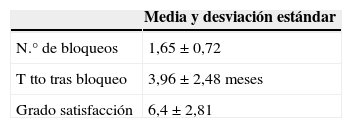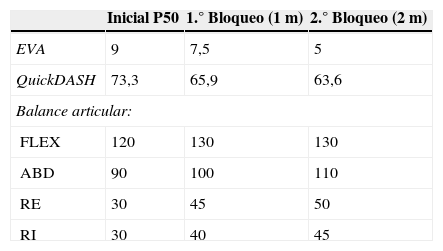Lo prioritario en la capsulitis adhesiva es controlar el dolor para mejorar la evolución y secuelas. Nuestro objetivo es valorar la efectividad del bloqueo ecoguiado en fases 1 y 2 y como tratamiento precoz.
Material y métodosEstudio cuasiexperimental de 41 pacientes con capsulitis y bloqueo ecoguiado del nervio supraescapular entre septiembre de 2012 y diciembre de 2013. Evaluamos Escala Visual Analógica, balance articular y QuickDash inicial, 1, 2 y 3 meses.
ResultadosTrece hombres y 28 mujeres, edad media de 56,6 años, con capsulitis unilateral en el 85,4%. Los antecedentes más frecuentes son diabetes mellitus (43,9%) con una evolución más lenta estadísticamente significativa e hipertensión arterial (36,6%).
Los tratamientos previos fueron analgesia oral (90,2%), cinesiterapia (78%) e infiltraciones (36,5%). Tras bloqueo el 41,5% fue alta, el 17,1% derivado a traumatología y un 31, 7% continúan en tratamiento con cinesiterapia (60,9%) e infiltración (14,63%). Solo un 9,7% fue derivado a la clínica del dolor por mala evolución.
Encontramos una relación significativa entre el bloqueo precoz y evolución más rápida (r=0,588).
Existe mejoría estadísticamente significativa respecto a la Escala Visual Analógica inicial (P50 9) tanto en primer bloqueo (7,5) como en segundo (5); en QuickDASH con 73,3 inicial, 65,9 en primero y 63,6 en segundo; y balance articular en los cuatro rangos de movimiento.
ConclusionesTanto dolor, funcionalidad como balance articular mejoran tras el bloqueo. Por lo que podemos plantearlo como opción inicial en el tratamiento de capsulitis.
No obstante, aconsejamos la realización de nuevos estudios de mayor calidad con guía ecográfica para corroborar nuestros resultados.
The main goal in adhesive capsulitis is to control pain in order to iad recovery and minimize sequels. Our aim was to assess the effectiveness of ultrasound-guided nerve block in phases 1 and 2 and as early treatment of this condition.
Material and methodsA non-randomized clinical trial was conducted in 41 patients with adhesive capsulitis and ultrasound-guided suprascapular nerve block between September 2012 and December 2013. We analyzed our results according to the visual analogue scale, articular range of motion, and QuickDASH at baseline and at 1, 2, and 3 months.
ResultsThe study group comprised 13 men and 28 women, with a mean age of 56.6 years; 85.4% of them had unilateral capsulitis. The most common antecedents were diabetes mellitus (43.9%), which was statistically significantly associated with slower recovery, and hypertension (36.6%).
Previous treatments were oral analgesia (90.2%), kinesitherapy (78%) and infiltration (36.5%). After the blockade, 41.5% recovered, 17.1% underwent surgery, and 31.7% continued kinesitherapy (60.9%) or infiltration (14.63%). Only 9.7% were referred to the pain clinic due to poor recovery. We found statistically significant differences between early nerve block and faster recovery (r=0.588), and between the initial visual analogue scale (P509) and after the second nerve block (visual analogue scale =5). The QuickDASH decreased from 73.3 at baseline, to 65.9 at the first block and 63.6 at the second. The four ranges of motion also showed significant differences.
ConclusionsPain, functionality and articular range of motion improved after nerve block, which could therefore be a suitable treatment for adhesive capsulitis. However, further and better-quality ultrasound-guided studies are needed to confirm our results.
Artículo
Comprando el artículo el PDF del mismo podrá ser descargado
Precio 19,34 €
Comprar ahora












